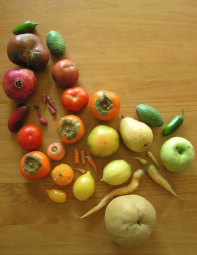Low-Glycemic Meals in Minutes
 Monday, January 28, 2008
Monday, January 28, 2008 Fellow dietitian, Laura Kalina, has co-authored a new new book and she has kindly given me permission to feature it on Greens & Berries.
Low-Glycemic Meals in Minutes features over 125 low-glycemic,
easy-to-prepare recipes, complete with menu plan, shopping list and
exercise strategies to help you achieve and maintain a healthy weight.
---------------------------
You can read more about Laura's background and the book on the website. Here's an excerpt and recipe that make me think this book could become a kitchen staple for making fast, healthy, at-home family meals -- what could be better?
The most common concern of today’s busy families is 'not enough time.' Lack of time, combined with the convenience and prevalence of fast food restaurants and prepackaged foods, has led to an unprecedented rise in obesity rates and chronic diseases such as type 2 diabetes and heart disease. Of particular concern is the tripling of childhood obesity in the last decade. This book will make your 'not enough time' concern a thing of the past. It focuses on the 'Quick Prep' method and shows you how easy it is to prepare healthy, well-balanced meals for your family in less time than a trip to your local fast food restaurant.
Tofu Lasagna
Phase 1 • Makes 6 to 8 servings
3 tbsp extra virgin olive oil
1 zucchini, chopped
2 red bell peppers, chopped
1 medium onion, chopped
4 cloves garlic, coarsely chopped
1 jar (24 oz/700 ml) Italian tomato sauce
1/2 tsp each dried oregano and dried basil
1 cup mushrooms, sliced with stems removed
1 cup low-fat mozzarella cheese, grated
1 pkg (300g) soft tofu
1 pkg (300g) frozen spinach, drained
2 pkgs (300g each) extra firm tofu
1/2 cup parmesan cheese, grated
1) Preheat oven to 350°F. 2) In a frying pan over medium-high heat, add 2 tablespoons of the olive oil and sauté zucchini,peppers, onion and garlic until onions are transparent. 3) In a large bowl combine tomato sauce, oregano, basil, and mushrooms. 4) In another bowl, mix soft tofu with spinach. 5) Slice extra firm tofu into 1/8-inch to 1/4 -inch slices to act as lasagna noodles.
6)Oil a 9 x 13 inch lasagna pan with the remaining olive oil. Pour a thin layer of tomato sauce on the bottom. Add a layer of tofu as you would lasagna noodles. Top with some of the spinach mixture and then some grilled vegetables. Sprinkle some mozzarella on top. 7) Repeat until all ingredients are used (you will have 2 or 3 layers). Top with remaining mozzarella and lastly sprinkle with parmesan cheese. 8) Bake for 45 minutes to 1 hour.

